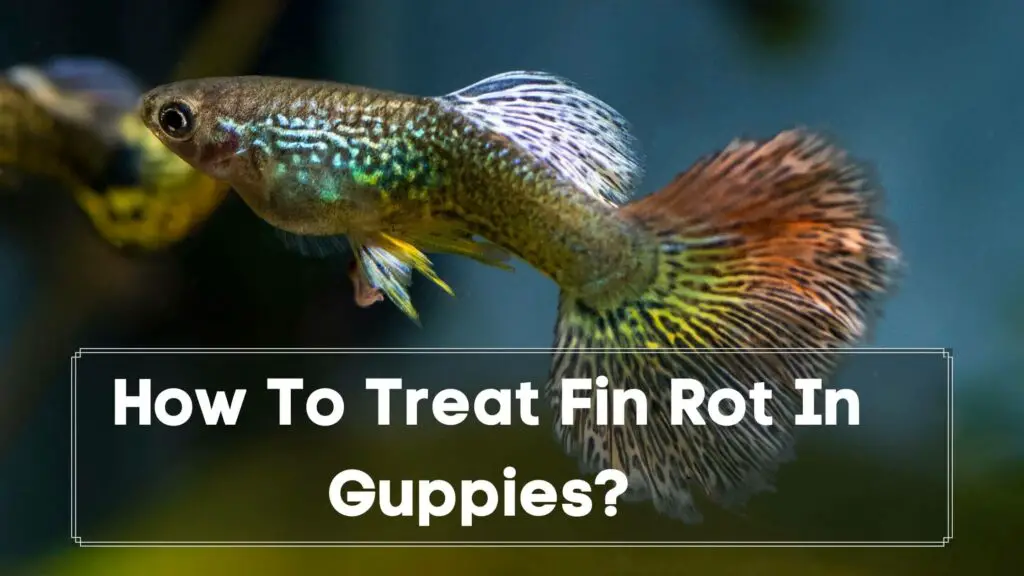There are various types of illnesses and infections which can harm your guppies. Fin rot is a common bacterial infection in guppies. This is a condition when the tails and fins of the guppy fish shrink.
Though it can be prevented easily, it becomes incurable in advanced stages and can even cause death. Let’s first know Why Guppy Tail Shrink
Article Contents
4 Reasons Why Guppy Tail Shrink?

There are many causes behind the fin rot in guppies. Though this disease can hint toward a more serious health disorder, the main cause of this disease is linked to the environment. It is communicable and can spread to the entire tank by other infected fishes in the fish tank.
This disease is mainly caused by bacterias such as Aeromonas, Vibrio, and Pseudomonas. Infected water in the tank and other fishes can transmit this disease through close physical contact.
Sometimes an infected fish can be seen nipping the fins and tails of other healthy fishes in the tank which is how the infection spreads and leads to fin rot.
Crowded Fish Tank
An overcrowded fish tank increases the chances of fin rot in fish. This depletes the quality of water, fluctuates the pH levels, and leads to an increase in the levels of nitrates, nitrites, and ammonia in the tank due to the overproduction of waste products.
Imbalanced Nutrients In The Tank
New tank syndrome can be one of the biggest reasons behind fin rot. This is most common in situations when the new tank is not cycled properly.
Appropriate cycling of the tank would make sure that ammonia gets transformed into nitrites and then into nitrates. This also stabilizes other water parameters, such as the temperature, water hardness, and pH levels.
If the tank does not get sufficient time for cycling, then the guppies can be put in danger which can lead to stress and various other complications in them. A rise in ammonia levels is also caused by poor maintenance, overcrowding of the tank, and overfeeding the guppies.
This can severely weaken the immune system of guppies. Also, a rise in ammonia and nitrite levels (poisoning) can make the guppies settle at the bottom of the tank, making them inactive and increasing the chances of fin rot.
Inappropriate Water Temperatures
Apart from nutrients, water temperatures also affect the immune system of the fish. Guppies need an ideal temperature range of 71 to 82 degrees Fahrenheit for their survival and can not endure extremely hot or cold temperatures.
You may also need to buy a heater to maintain the optimum temperature of the tank. Extreme temperatures give rise to a lot of complications which usually weakens their immune system and can lead to fin rot.
Inappropriate Tank Setup
Inappropriate tank setup can also be a major problem apart from lack of heaters.
Guppies usually need a large-sized tank (at least weighing 5 gallons) to give them enough space to swim.
Introducing live plants is also important to prevent fin rot in guppies. You can also use a good-quality artificial plant to protect them from such ailments. Also, keeping them on sand gravel reduces the chances of their fins getting caught.
If the proper setup of the tank is not done, it becomes risky to keep guppies with other fish. This may even cause some serious problems such as imbalanced nutrients, fin nipping, pH fluctuations, and a lot of stress in guppies.
What You Should Do?
Several antibiotics can be effective in treating fin rot, but you must tap the root cause of the problem to make sure the disease does not come back again.
You must carefully examine all the tank water conditions and change the water regularly every week. If there is an accumulation of food particles and debris, you must clean the gravel and avoid overfeeding at all costs.
Including dates on their fish food can cause vitamin loss immediately after opening the food container.
You must feed the guppies good-quality, fresh foods in optimum quantities rather than overfeeding them with stale foods.
Ensure the ideal water conditions of the fish tank. You must monitor the temperature and pH levels of water regularly, and make sure they are at the optimum levels.
You should also prevent the deposition of nitrite, chlorine, ammonia, or other heavy metals in the tank water and make sure the nitrate levels are always below 40 ppm.
This helps correct the root cause of the problem and now you can make use of antibiotics to cure fin rot. For this purpose, you need to consult a well-known aquatic vet.
You must carefully follow the recommendations of your vet as the composition of medications used for treating fin rot may vary from one manufacturer to another.
It is also important to continue the treatment for the recommended period, else there is always a chance that the disease may come back.
You can also use aquarium salt in the tank as it can be effective in preventing the disease.
The tank environment should be comfortable and clean to speed up the recovery process of guppies.
You can add a sponge filter or air stone to increase the oxygen levels in the fish tank.
Is It Deadly?
Though measures can be taken to prevent fin rot in guppies, it becomes difficult to cure when the disease sets in, specifically if it reaches an advanced stage. If the root cause is not tapped and proper treatment is not done on time, it can be deadly and can infect other fishes in the tank.
- What are the Ideal Water Parameters for Guppies?
- How to Setup Refuge for Guppy Fry?
- 12 Reasons Why Guppies Die? + Prevention Tips
How To Treat Fin Rot In Guppies?

Fin rot can be a serious bacterial disease in guppies. There can be many reasons behind this disease some of which include improper tank conditions or getting exposed to other infected fishes.
Here are a few steps that can be taken to cure fin rot in guppies:
1) Separating The Infected Fish: Place the infected guppy in a separate tank that consists of freshwater free from chlorine.
You should not share nets and use a different net to reduce the chances of fish rot. Keeping the infected guppy with other fish in the same container may spread the disease to other fishes.
2) Keep The Tank And Its Accessories Clean:
You should first empty all the dirty water from the tank into the sink. You also need to remove the gravel and other tank accessories.
Now, scrub the tank with hot water without using soap. Clean the crevices of the tank properly. Also, soak all the accessories in warm water for a few minutes. Wash the gravel thoroughly to eliminate the debris.
3) Opt For A 100% Water Change:
If your tank has not been cycled yet, you need to use conditioned water and perform a 100% water change. Also, keep the water temperatures from 71 to 82 degrees. You may also have to clean the water filter.
4) Avoid Tank Overcrowding:
Crowded spaces and Congested mates increase stress levels and lead to various ailments such as fin rot. Allow only 2.5 cm-sized guppies in every 2 gallons of space.
5) Control Guppy feeding:
Give them good-quality optimum nutrition to avoid diseases like fin rot.
6) Continue The Medication:
Listen to your aquatic vet and give them prescribed medications for their proper cure.
7) Monitor The pH Levels:
Make sure the pH levels are around 7 with the ammonia levels staying below 40ppm.
Summary
Fin rot is a very common disease caused by bacteria in the guppies. It usually makes their tail and fin shrink and can be deadly if the appropriate treatment is not done at the right time. It can also spread from one fish to another. Hence you need to separate the infected fish from other fishes.
This is mainly caused by overcrowding of fish in the tank, not cycling the tank, overfeeding the guppies, improper cleaning of the tank, or getting exposed to other infected guppies. Proper treatment should be done as per the vet’s advice to cure this disease.
We're an affiliate! When you purchase something through my affiliate links, I earn a small commission.Thankyou if you use them.

